Unity of Command News
Gamescom Update - What’s in the Cards?

We are descending on the fair city of Cologne, Germany this week to attend Gamescom, the world's biggest gaming expo. Our chosen screenshot should be appropriate then, as one of the objectives for the Rhine crossings of March 1945 was indeed Cologne and its bridges.
The major reveal here are the support cards. This is a new mechanic for the UoC series, and it lets us show a side of the war that can’t be represented as units on a map. The player can buy the cards with prestige, or receive them as rewards for taking bonus objectives.
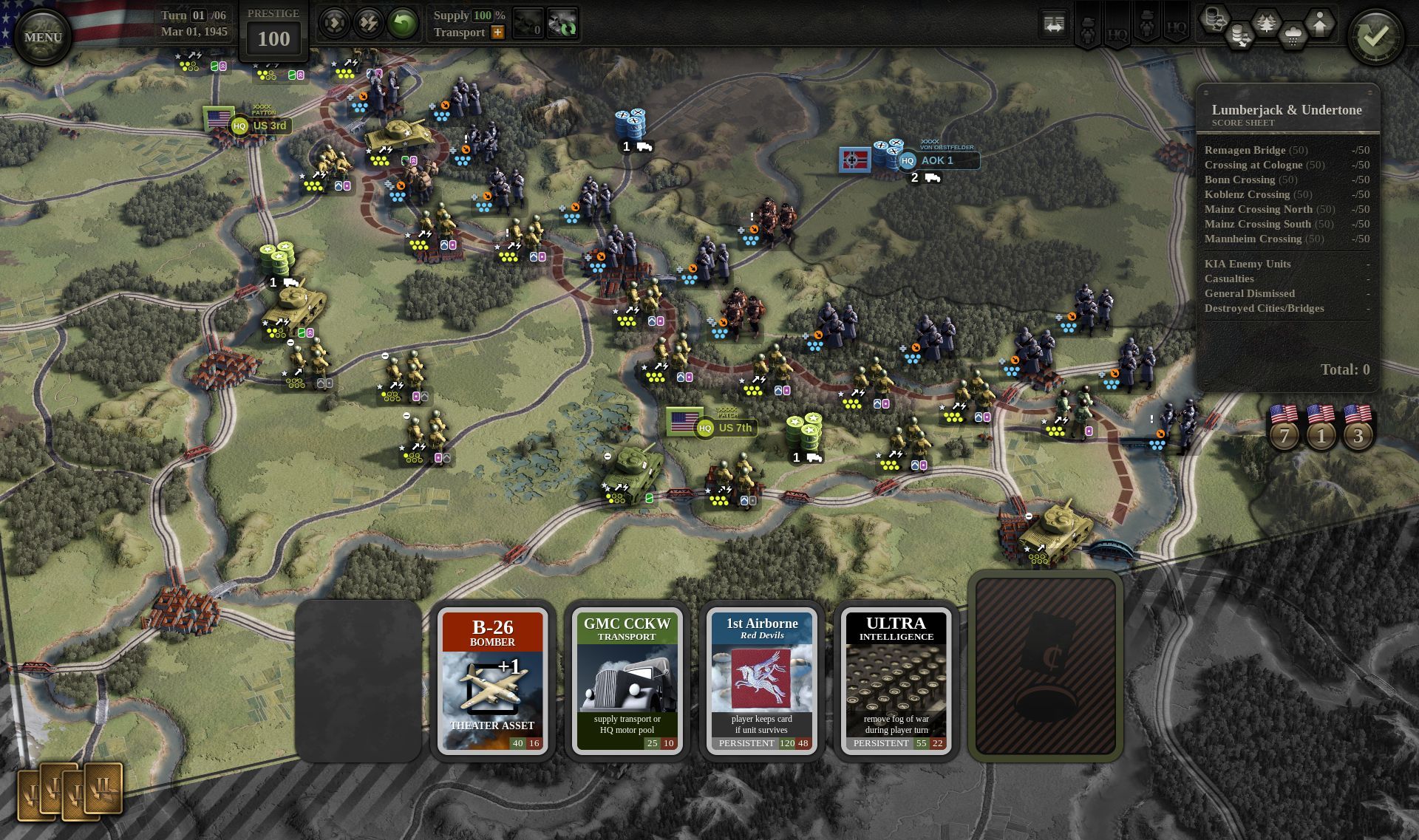
Theater asset cards are the simplest, yet very powerful. The B-26 gives you an additional air attack for the duration of a scenario, which can be enough to turn the situation around if played at the right time.
GMC CCKW (truck) card is interesting because it can be used in two ways: to increase the range of your supply network or to motorize the units (of one HQ). This “motor pool” ability simulates the superior transport capabilities of the Allies, but there is a real tradeoff with supply, especially in 1944 France scenarios.
The really cool option is taking control of the Red Devils. Cards like this are the most expensive, and don’t come up often. They let you make divisional para drops about once every three scenarios, providing your unit doesn’t get killed in the drop. This is a quiet nod to what happened in Market Garden so don’t be reckless with your paras there.
Trailer and Release Plans
We have a new trailer, which is up to date with the current state of development. It’s already on our steam page, or you can check it out on youtube right now:
https://youtu.be/S_5VF-hwu_0
Release Update: we have updated our release target to “Fall 2019” (also in the trailer). A full release before the end of Q3 now looks unlikely, but we’re still on track to at least go into beta. The plan, as always, is to make the best game possible. We will continue to keep you updated on our release plans as we go along. Thanks for your patience 🙏.
Live Stream
Our Gamescom live stream will be available here on UoCII Steam page on Wednesday, August 21 at 8 pm CEST.
Daniel Mellbin, our scenario designer, will be playing UoC2 live for the first time ever, so save the date if UoC2 is your thing.
We will be in the trade visitor section at Gamescom, so if you’re lucky enough to be in attendance, be sure to drop by the Croatian booth and say hi! (Booth A-011, Hall 3.2)
Cheers,
Tomislav
Developer Diary 23 – A Seaborne Invasion

In recent weeks, we put a lot of effort into making sure that seaborne invasions play well in the game. This is important because these air/naval operations were such a feature of the Allied campaign. Counting just the historical ones, there’s six: Torch, Husky, Salerno, Anzio, Normandy, and Dragoon.
Granted, we have decided to start the campaign at Wadi Akarit, after the Torch landings, but that still leaves us with five so… invasions aplenty. Speaking of Torch, the period between it and the allied link-up in Tunisia will now feature in the tutorial, not the main campaign. Sadly this leaves Kasserine Pass outside the campaign, but we’ll try to make it up with a standalone scenario.
We’ve been working on the campaign quite a lot, and since campaign play revolves around HQ upgrades, I feel that it’s time to do a proper Headquarters deep dive. In fact, the bulk of this post will be about HQs and the campaign, but let’s quickly talk about invasions first because there is a screenshot, and it is a-mazing.
The invasion force in the screenshot below is typical for Allied operations of this kind. It has battleships providing naval defensive fire, LCVP landing craft ferrying the units involved in the naval assault, and a plane carrying paratroopers. It should really be a C-47 but we don’t have them in the game yet (can you tell which plane we’re using instead? Also, which bb?)
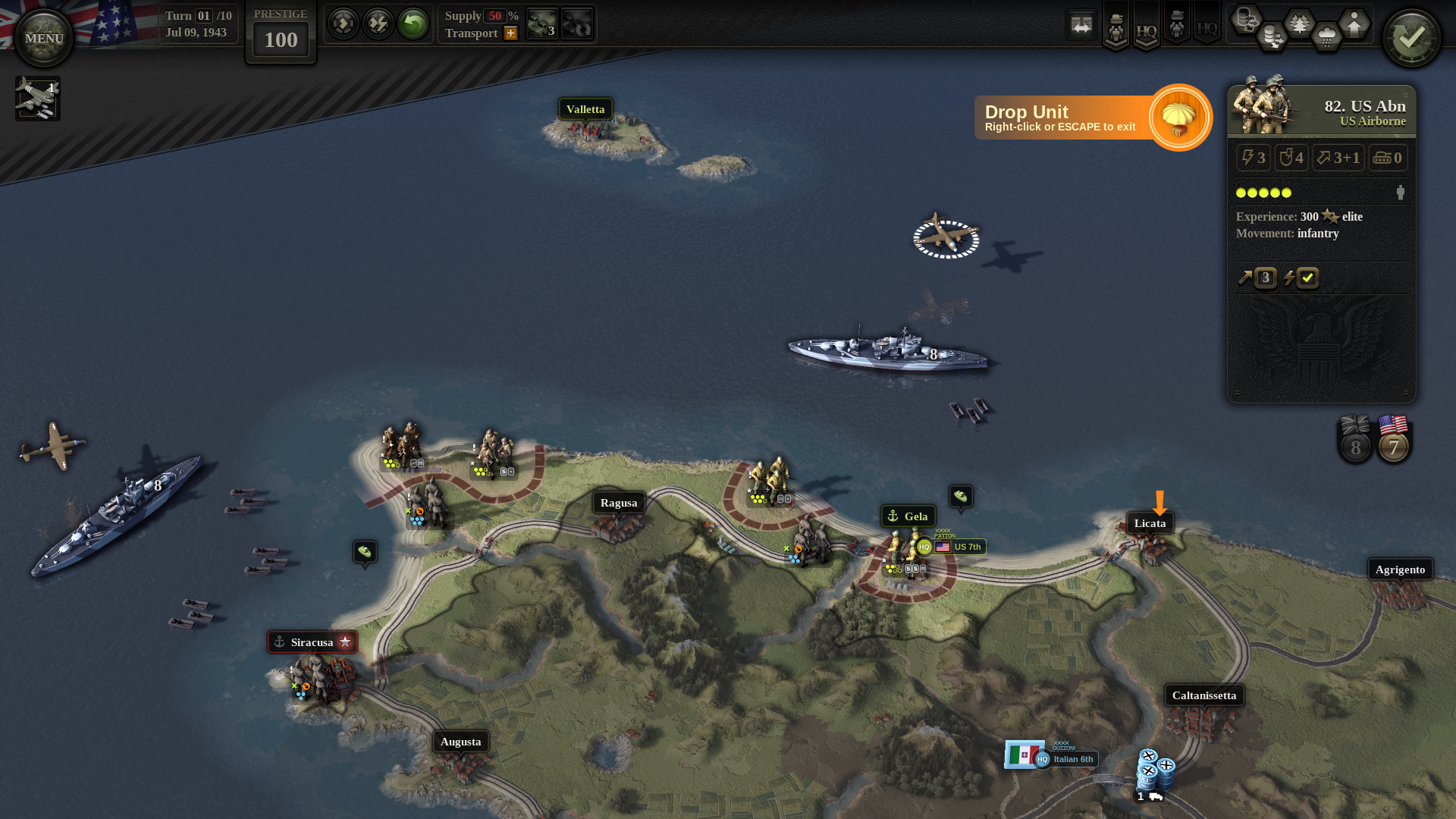
Mechanically, naval assaults and para drops basically do “what it says on the tin”. Assuming an assault goes well, the unit lands with no MPs and no AP, or with its AP locked if the landing was unopposed. This is consistent with other game mechanics, such as river crossings.
On the following enemy turn, the battleships will be providing naval defensive fire, covering the landing beach hexes. This works out to a -3 artillery (-like) shift against any enemy units attacking our units on the beach.
HQ Command Points
We already mentioned HQs in earlier diaries, and described how they are used for various command and support actions. The actions include everything from bridge repairs to unit reorganization, and performing each one costs some number of command points (CPs).
The number of command points available per turn represents overall commander and staff proficiency of an HQ – there are only so many things an organization can do at once. While coordinating a set piece attack at the front, the HQ can’t also be building fortifications or doing emergency supply runs.
As the campaign game progresses, the number of CPs per turn can be increased. This represents an improvement in HQ staff skill, and happens at times when its units have earned enough xp to merit an upgrade. At that point, the player may choose to increase the number of CPs per turn (overall skill) or to reduce the CP cost of one specific action (specialize).
HQ Branches
HQs are divided into five branches: Force Pool, Intel, Operations, Logistics, and Engineering. Every action belongs to some branch: for example, bridge repair to engineering. Branches are further divided into three levels, not all of which are always unlocked.
In the screenshot, the US II Corps HQ has Level-1 Force Pool, meaning only deploy and reorg actions are available. The higher levels of this branch are locked, and so transfer step and security unit actions are not available to the player.
The player can unlock higher branch levels at conferences, which are breaks in the campaign game that happen once every six months or so. At a conference the player can, among other things, spend prestige to unlock higher levels of HQ branches.
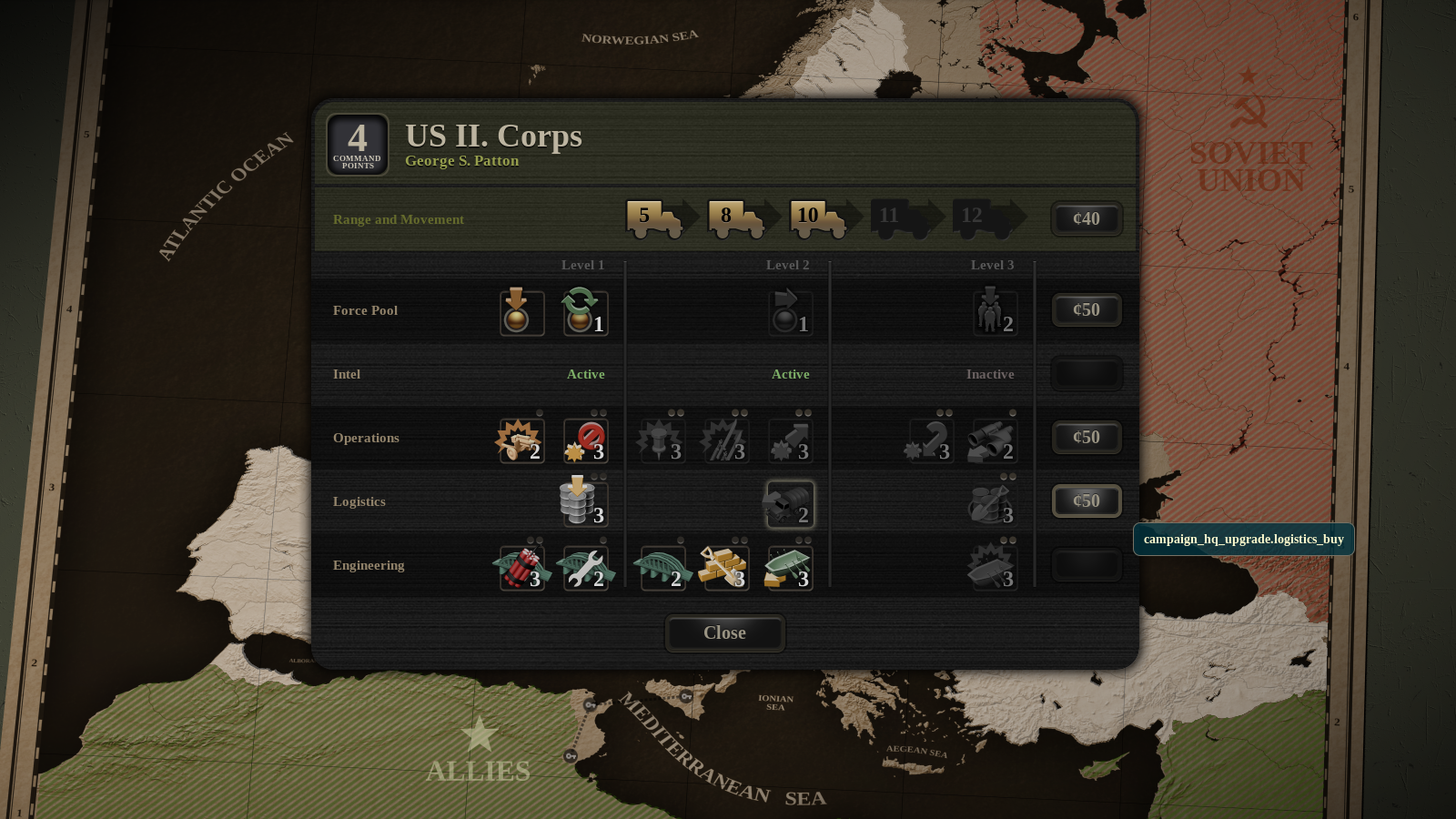
HQ Movement and Range
In the screenshot, you can see that HQ range for the US II Corps equals 10 movement points (MPs) or 3 trucks. The trucks represent transport assets, which are also used in the supply system. Upgrading to add more trucks is possible, but it increases the MPs less and less (5 – 8 – 10 – 11 – 12). This is because increasing HQ range needs to cover an ever larger area.
When an HQ moves, it generally uses the same number of MPs as its range (10 in this case). It then gets 3 more MPs if it moves via uninterrupted rail movement. This is the case for all the HQs we’re actually using in this campaign, but we’ve built some additional flexibility into the system.
Just to give you a taste: one of the possibilities left open for future development is a “mobile” HQ that has a fixed, smaller range, but whose movement is fully upgradeable. This is something we would want to use for a German panzer corps for example, or maybe a late-war Soviet cavalry mechanized group.
In Other News
We released another mini-trailer last week. You can find it in the announcements section here: Death from Above – AI and Airpower Trailer. We are doing a lot of work on localization, testing with a small group of languages to make sure the translations don’t break UI layouts etc. There’s a lot of tweaking ongoing (tweakage?), many fixes and generally the game starting to look like the real thing.
The work continues!
Tom
https://store.steampowered.com/app/809230/Unity_of_Command_II/
Death from above
 November 1944. The city of Metz, located near the German border, still stands in the way of Allied push across France towards the heart of the Third Reich.
November 1944. The city of Metz, located near the German border, still stands in the way of Allied push across France towards the heart of the Third Reich.Patton’s Third Army had been fighting fiercely since early September to dislodge the Germans from the heavily fortified city, suffering casualties that approached 50%. Hitler had ordered that the city, and the fortress complex around it, were to “hold at all costs”.
Metz did hold. It was one of the greatest shows of resistance by the Third Reich in World War II.
Eyes on the Sky
That is, of course, until December when the last of the city’s defenders were forced to surrender. To help put things into perspective, Americans had more than 3.500 fighter planes and even more bombers available. Together with the Royal Air Force, the combined Allied air strength on the Western Front was almost 14.000 planes.
Luftflotte 3, protecting the German armies on the Western Front, had less than 600 available aircraft. It’s safe to say that Allied air forces held overwhelming superiority over the Luftwaffe in western Europe. German commanders pleaded with Hitler to allocate at least 700 more planes to the area. There was even talk of Luftwaffe’s secret weapon, one so powerful that it could turn the tide of war: world’s first operational jet fighter!
Messerschmitt 262 jets were real and deadly, but in reality jets were barely operational by the time the Battle of Metz took place and were too few in numbers to make a difference. The rest of the requested planes never arrived.
Even with clear air superiority, the Third Army was still bogged down in the mud, unable to advance. There were several reasons for this:
- P–47’s carried 500-pound bombs that had little effect on reinforced concrete and bunkers around Metz
- Tactical Air Command that supported the Third Army was too dispersed (flying both Metz and Brest, almost 800 kilometers apart)
- Metz would open up a route to Frankfurt and Saar, and the Saar route was a lower priority compared to the lower Rhine and the Ruhr. Ruhr>Saar.
- Finally, and most importantly - the bad weather
It is I, AI!
Unity of Command II takes Allied air superiority into account throughout the campaign. Let’s take a look at the trailer:
https://youtu.be/vEpQiXJxp2Y
As soon as the weather clears, the player is given control over thee off-map tactical air force actions that provide recon, air cover and close tactical support for the attacking units on the ground. Bombers are called into action in the video, but Unity of Command II will feature more aerial actions, such as air reconnaissance. Airdrops will also be available, depending on the scenario, date, and your progress in the campaign. As long as there aren’t any large scale ops, attempts to supplement ground transport with the air transport proved effective on the Western Front and the game will mimic these solutions as well.
The trailer ends with the encirclement of Metz, an outcome that wouldn’t be possible without air support. The enemy counter-attack was fierce and, depending on the difficulty settings, a solid show of what the game’s AI is capable of. Or indeed, what the German generals were capable of.
Shield and Sword
The game’s AI takes into account mission objectives, player’s moves and also consults some of the historical moves before taking action. The brutal panzer counterattack that the AI selected as the best option in the trailer mimics the Schild und Schwert (Shield and Sword) tactic mastered by the best defensive commanders of the Third Reich, and is a precursor of what the Allies will have to endure in the Ardennes in December.
Defensive tactics managed to keep the Third Army at Metz for almost three months, which bought time for Hitler to shore up the Siegfried line where many more lives were lost. Still, was Patton’s decision to order a frontal attack on one of the most heavily fortified cities in Western Europe necessary? What would have happened if the fortress was bypassed? Or was there a way to encircle it and take the city in, shall we say, few turns less? Unity of Command II will be out soon - what will be your strategy for Metz?
A full development update is due next week on our blog (will also be re-posted here on Steam). In the meantime, as usual, feel free to AMA in the comments.
Cheers,
Tomislav
https://store.steampowered.com/app/809230/Unity_of_Command_II/
UoCII Developer Diary 22 – Halted at Metz
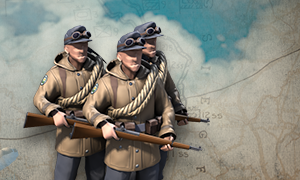 September 1944. Hitler’s armies are retreating in disorder after their defeat in the Normandy hedgerows. The Allies keep up the chase across France, but General George Patton’s 3rd US Army is beset by supply difficulties. The Germans finally manage to re-establish a defensive line around the heavily fortified medieval city of Metz. According to orders issued by Hitler, fortress commanders are to hold this position at all costs…
September 1944. Hitler’s armies are retreating in disorder after their defeat in the Normandy hedgerows. The Allies keep up the chase across France, but General George Patton’s 3rd US Army is beset by supply difficulties. The Germans finally manage to re-establish a defensive line around the heavily fortified medieval city of Metz. According to orders issued by Hitler, fortress commanders are to hold this position at all costs…Encouraged by good feedback from our previous post, we decided to start on a series of short trailers about our game mechanics, old and new. The story starts with the 3rd Army actions following the long and bloody stalemate at Metz. It is through a series of coincidences that we are again going on about stragglers (sorry!) but I hope the trailer is worth it for everybody. There is also a lengthy development update at the end of the post, as usual.
Halted at Metz
The Battle of Metz resulted in heavy casualties on both sides, and while the exact German losses remain uncertain, it is known that the 3rd US Army took at least 75.000 prisoners during the operation. For the US forces bogged down in the mud, this created a significant logistical problem, in addition to other hardships.
The scenario starts in November, after weeks of horrific stalemate. The Germans had a moment to regroup and now they’re dug-in. The confluence of rain-swollen rivers of Moselle and Seille creates a natural obstacle to frontal assault and the terrain has all turned to mud. There won’t be any grand sweeping maneuvers here. The battle of Metz will be a slugfest.
https://youtu.be/VQXbNybumIY
The city itself is protected by a deadly network of heavily armed forts with siege guns, some of them complete with medieval moats (that still work perfectly against tanks). The two US divisions shown in the video have the right idea as they go into the attack, trying to outflank the fortification.
Advancing US forces are taking prisoners along the way. If they take enough during one turn, they will provide valuable intel. In this case, the 6th Armored managed to gather that intel, but it’s just more bad news for the 3rd Army: the road to Saarbrücken is heavily guarded by German armor. Airpower could help with this threat, but the weather would need to improve first.
What would you do? Would you wait for air support to deal with the panzers? Order a full frontal attack on Metz? Bypass the city entirely, waiting for lack of supply to catch up with the defenders? With every passing day the industrial production of the Ruhr and the Saar continues contributing to enemy war effort or, in game terms, your prestige sinks lower and lower.
It’s the UI, Stupid
Realistically, most of our time is spent working on the UI. It is simply the most important aspect of a strategy game, period. However great you make the game mechanically, most of the good stuff will remain forever buried unless you make it accessible. With that in mind, we keep adding and streamlining stuff, so here it goes.
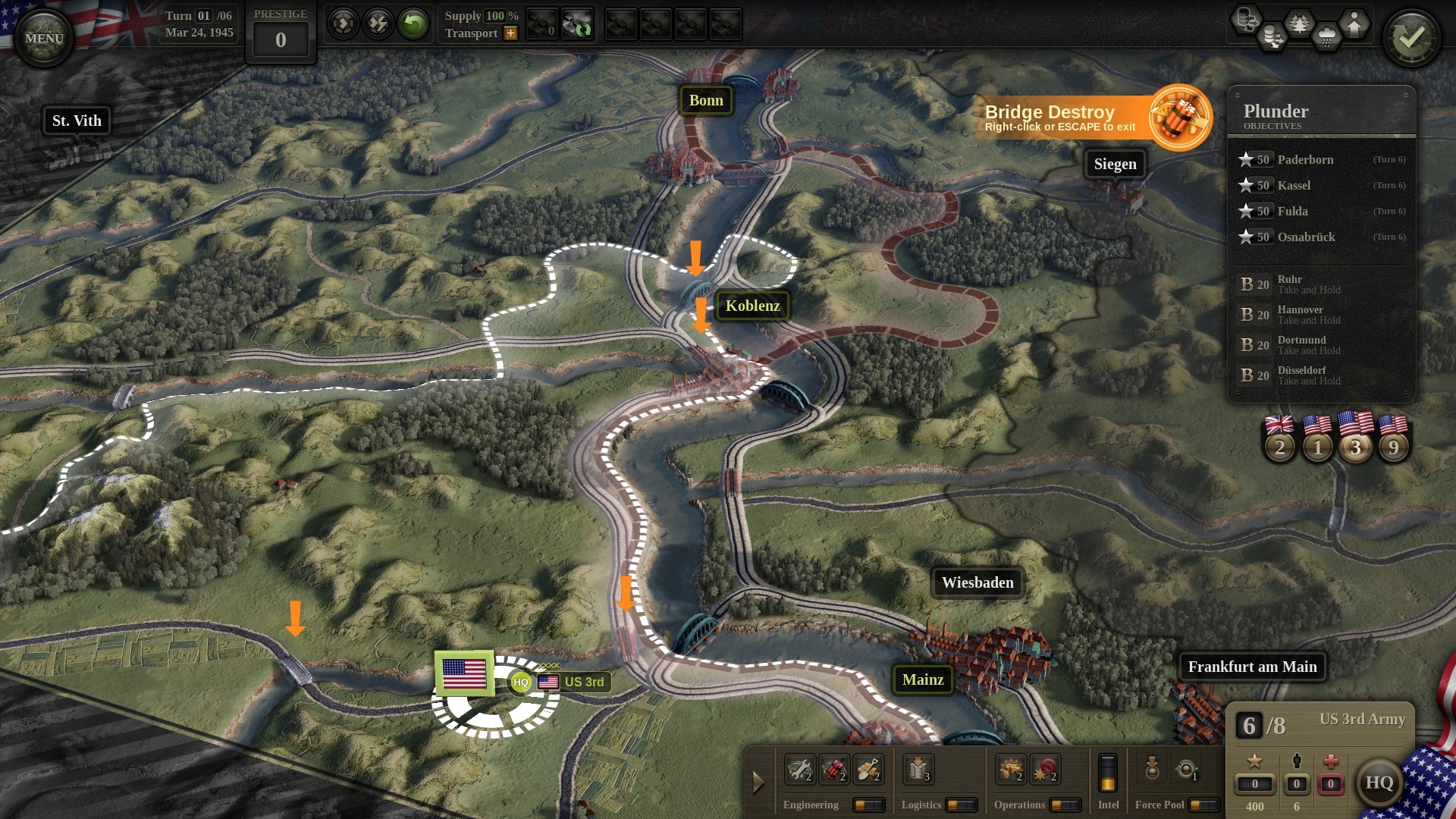
We have asked the 3rd Army HQ to highlight any bridges that can be blown in this turn. This removes all units from the map for clarity, highlights the bridges, and shows the orange banner in upper right. We’ve found that the banner is often needed. Sometimes via the hotkeys and UI buttons you’ll switch the game to some unknown state and be left wondering: where on earth have my units gone?!
The HQ itself is shown in a pretty basic configuration, with all of its branches at default levels, i.e. not upgraded. This HQ provides the following actions (left to right): bridge repair, bridge destruction, entrenchment, emergency re-supply, suppressive fire, no retreat, deploy and reorg. Actions are then grouped into branches: Force Pool, Intel, Operations, Logistics and Engineering.
The division into branches is inspired by the general staff system used in western militaries: G-1 for personel, G-2 for intel etc. Each HQ can be upgraded differently during the campaign, giving the player some interesting choices about how to adapt to the situation and his own play style. In general, upgrades will provide the HQ with new and advanced actions, such as recon-in-force, security units, etc.
Short Updates
The work continues on many fronts, and I’m never sure how useful are these short updates that I give at the end of my blog posts. Let me know in the comments if you think they are. But first, here is a screenshot of the Italian peninsula from way above. It’s pretty to look at, eh?
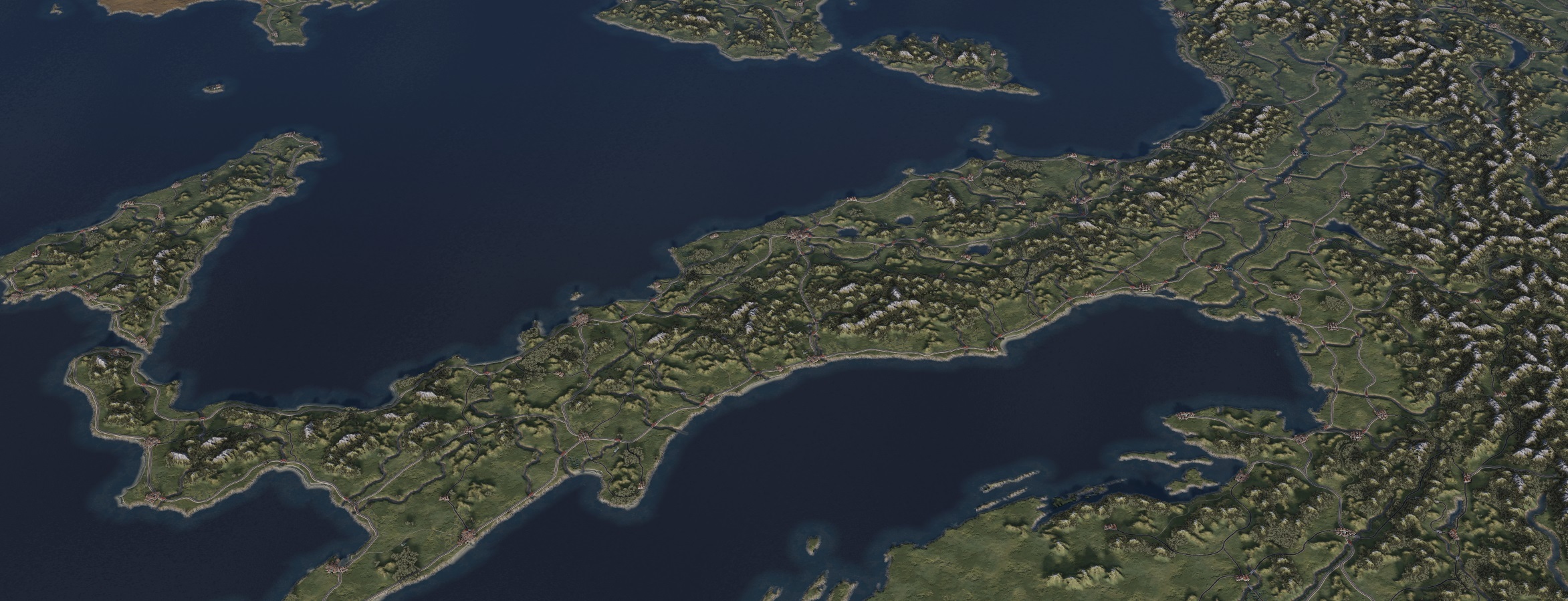
We’ve kept adding more and more workflows of the “bridge destroy” type shown above (and mentioned in Developer Diary 20 to number around 36). To be honest, I’ve lost count of them, but now that we understand how to add them systematically, we just keep adding more wherever we feel it’s needed.
We also started working on a human-readable AI Playbook. To explain: our AI has always been a heuristic one, not the deep learning kind that’s getting all the media coverage lately. We’d translate some part of a player’s thought process into computer code, which we then call a tactic. The job of the AI is to look for tactics that are applicable in any given situation.
The playbook is the next step in our AI development: it’s a human-readable catalog of tactics that is accessible to team members who are not programmers. It took some time to nail the correct format, and I don’t think scenario designers and players will be able to contribute to the playbook directly just yet. It should be a great tool for this though: when the AI programmer and the scenario designer sit down to discuss, they will have a common language to describe what the AI is doing. Even better, they will be able to record any new tactical ideas in a way that’s understandable to both. I expect great things!
At the last minute Daniel has noticed there is a historical error in one of the images in this post. Can you spot it?
The work continues!
Cheers,
Tomislav
